Key takeaways:
- Post-conflict recovery emphasizes both emotional healing and rebuilding trust, highlighting the importance of vulnerability in forming connections.
- Group therapy fosters a sense of belonging and accountability, facilitating personal growth through shared experiences and diverse perspectives.
- Techniques like vulnerability, constructive feedback, and mindfulness learned in therapy can significantly enhance interpersonal relationships and daily life.
- Empathy develops through active listening and sharing stories, creating a deeper understanding and connection among participants.
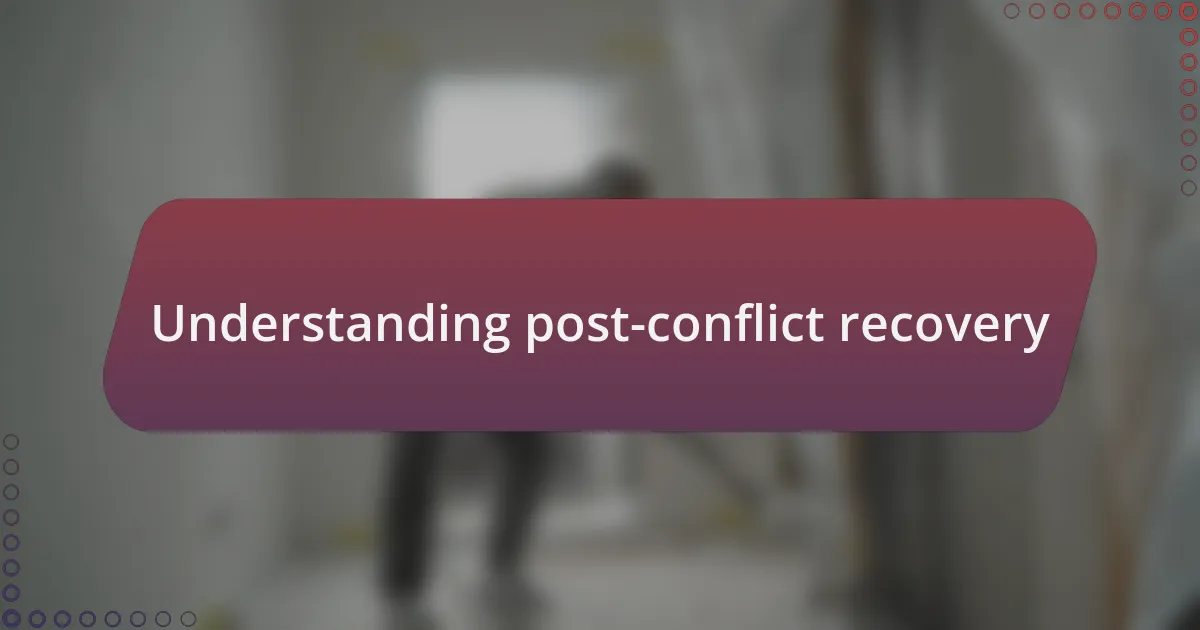
Understanding post-conflict recovery
Post-conflict recovery is a journey that extends far beyond the absence of violence; it’s about healing the emotional scars that linger long after the storms have passed. I remember sitting in a circle during one of my group therapy sessions, surrounded by people who had experienced profound losses. This shared space allowed us to confront the unspoken pain that binds us together. Isn’t it interesting how the power of connection can turn overwhelming grief into a collective strength?
When we think about recovery, we often focus on rebuilding infrastructure or policies, but emotional recovery is equally crucial. In my experience, discussing personal narratives in therapy helped me understand how other participants processed their trauma differently. It made me question: How do our individual journeys contribute to a larger narrative of healing? Sharing my story and hearing others helped me see not just my suffering but also my resilience, which often went unnoticed.
Moreover, the process of rebuilding trust in oneself and in others is a vital aspect of post-conflict recovery. I’ve felt the weight of doubt creeping into my daily life, challenging my ability to form relationships after experiencing loss. Yet, every time I participated in group discussions, I was reminded that vulnerability is not a weakness; it’s a pathway to rebuilding hope. How many times have we underestimated the significance of genuinely connecting with others on similar journeys?
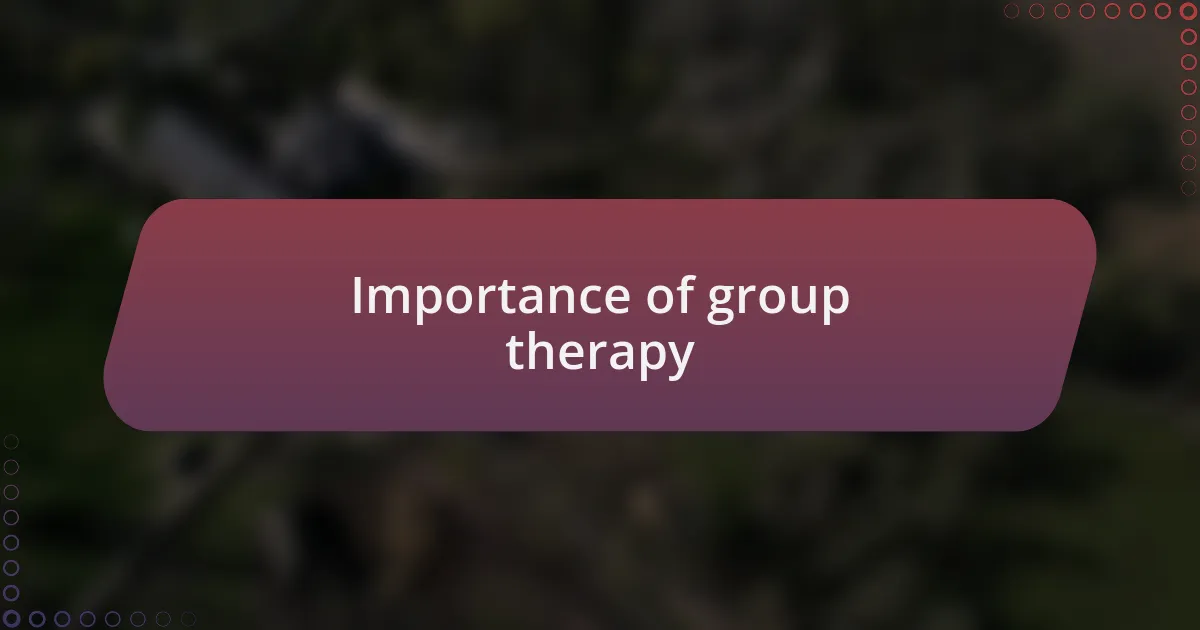
Importance of group therapy
The beauty of group therapy lies in its ability to create a sense of belonging among individuals who share similar struggles. I recall one session where someone shared a particularly painful memory, and the room fell into a profound silence. In that moment, I realized we were not just participants; we were a community united in our healing. Isn’t it reassuring to know that you are not alone in your pain?
What I find fascinating is how group dynamics can catalyze personal growth. Watching others articulate their fears and triumphs pushed me to confront my own baggage. It was through observing these exchanges that I learned the power of empathy—how understanding someone else’s journey could illuminate paths within my own. Have you ever found inspiration in someone else’s resilience?
Furthermore, the feedback and support offered in these sessions are invaluable. I remember a moment when another participant shared a strategy that had helped them cope with anxiety. It sparked such a light in me; I immediately felt that I wasn’t just a passive listener, but part of a dialogue that nurtured solutions. Collective wisdom, after all, has a way of unlocking insights that we might overlook on our own. Don’t you think it’s incredible how shared experiences can lead to meaningful breakthroughs?
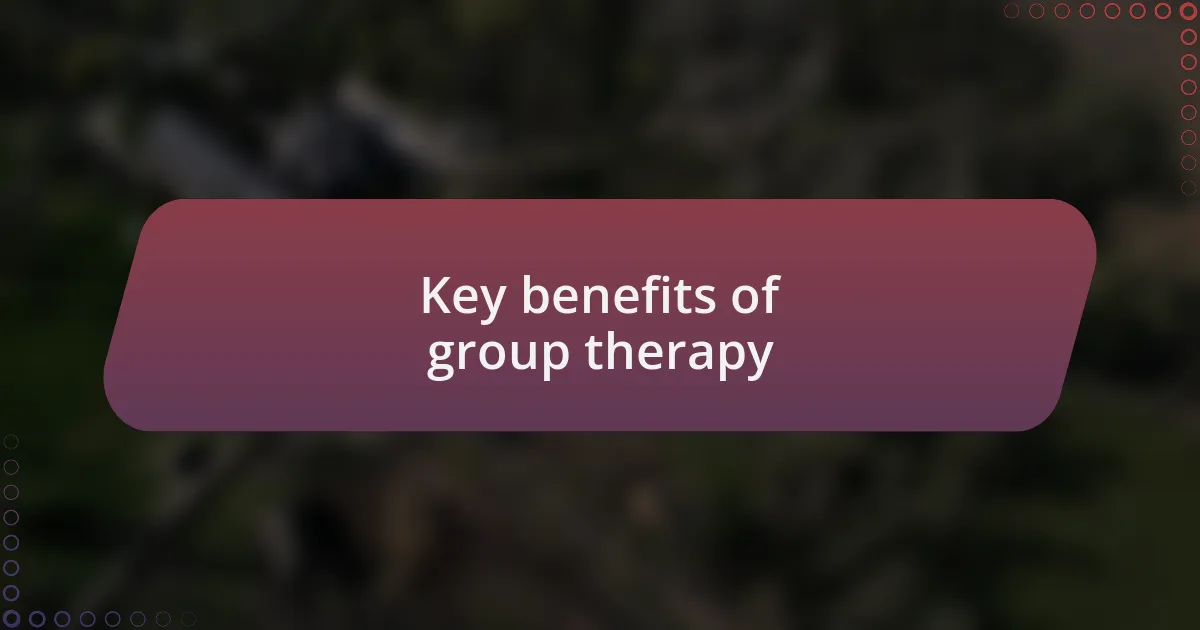
Key benefits of group therapy
One of the standout benefits of group therapy is the diverse perspectives that each member brings to the table. I vividly remember a session where participants represented various backgrounds and experiences. Hearing how each person tackled their own challenges shed light on avenues I hadn’t considered before. Have you ever found that someone else’s story resonated so deeply with your own that it sparked a new idea for you? It’s those moments of connection that can be truly transformative.
The accountability that comes from group therapy is something I’ve found particularly empowering. I recall committing to take small steps each week, like journaling or reaching out to a friend. When I returned to the group and shared my progress, the encouragement from others fueled my motivation. It’s amazing how knowing that others are invested in your journey can push you toward achieving your goals. Could this accountability be a secret ingredient for sustained personal growth?
In addition to the support and insights, the practice of active listening in group therapy profoundly impacted my ability to communicate effectively. I learned the importance of being present and truly hearing what others had to say. A breakthrough occurred when I realized that by listening without judgment, I was not only helping others but also deepening my understanding of myself. How often do we miss the chance to connect due to distractions? Being fully engaged makes all the difference.
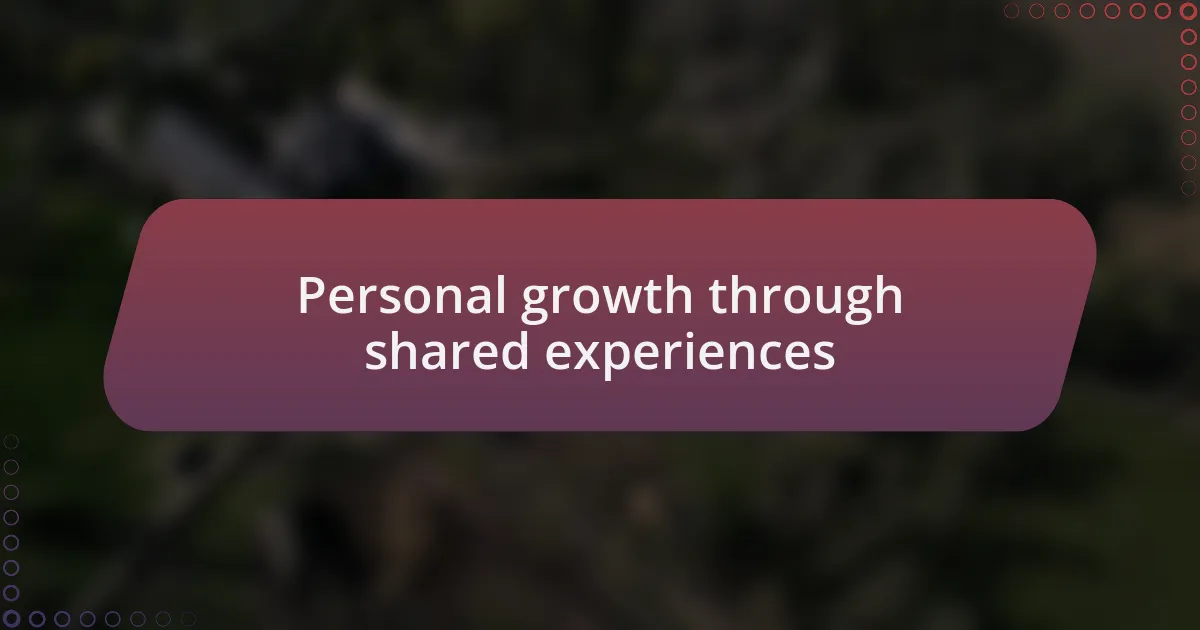
Personal growth through shared experiences
In group therapy, I discovered that sharing vulnerabilities creates a profound bond among participants. I remember a session where someone candidly discussed their struggles with anxiety, and it struck a chord with me. Listening to their story made me realize I wasn’t alone in my feelings. Have you ever felt a deep connection with someone just because they shared their truth? That moment taught me the power of vulnerability in fostering personal growth.
As we navigated our experiences together, I realized that every shared story was a lesson in resilience. There was one instance when a member shared how they overcame significant loss. Their courage inspired me to look at my own challenges in a new light. In what ways could we all benefit from someone else’s triumph over adversity? Hearing how others prevailed helped me instill a sense of hope in my journey.
The camaraderie built through these shared experiences is something I cherish. I recall leaving a session one day feeling lighter and more empowered, equipped with new perspectives and strategies for coping. Isn’t it amazing how simply being in the same room with others who understand your struggle can pave the way for self-discovery? That sense of collective growth truly transformed my understanding of what it means to heal together.
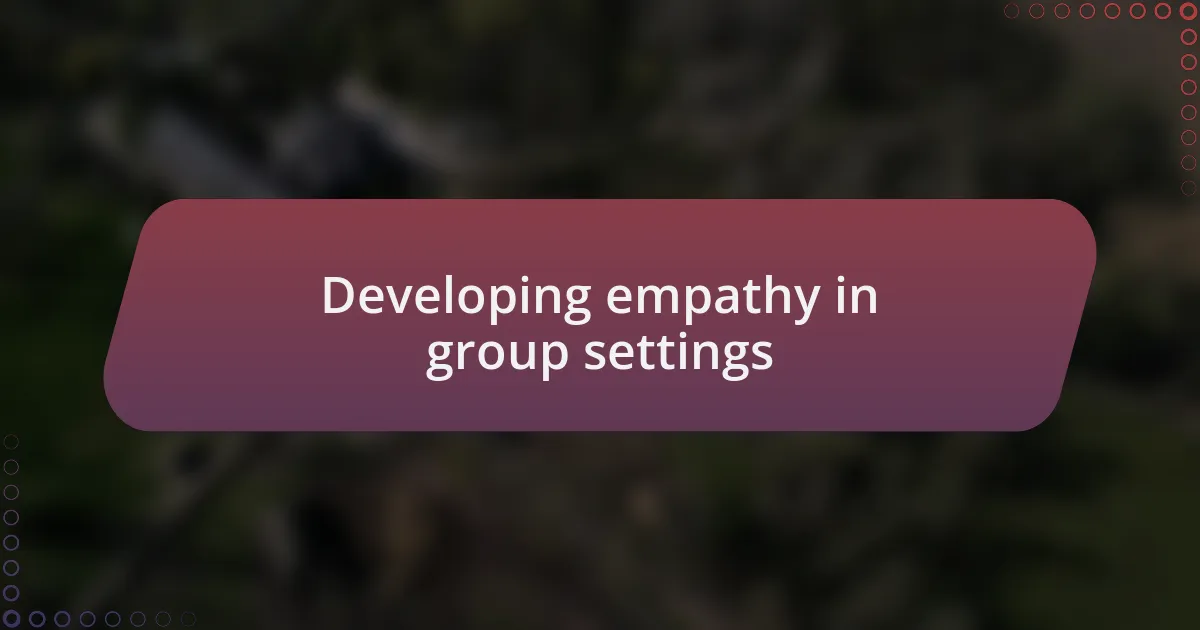
Developing empathy in group settings
In group therapy, the practice of sharing thoughts and feelings encourages the development of empathy among participants. I recall a moment when another member expressed their frustration over feeling misunderstood by family members. As I listened, I felt a shift within myself; I began to see how my own struggles mirrored theirs. Isn’t it interesting how one person’s experience can awaken empathy in another, leading to a deeper understanding of our shared human condition?
While listening to others in the group share their stories, I noticed how often we find common ground. One day, someone spoke about their journey to forgive a loved one, sparking an involuntary reflection on my own ability to forgive. I felt a wave of compassion for both them and myself, realizing that empathy doesn’t just exist in isolation; it flourishes when we acknowledge the stories that connect us all. How many times have you recognized your own experiences in someone else’s tale? Those moments remind us that empathy can be cultivated through active listening and shared vulnerability.
The environment in group settings creates a unique space for empathy to blossom. I remember a session where we practiced active listening exercises, and the change in atmosphere was palpable. By focusing solely on each speaker, we allowed ourselves to inhabit their emotions, fostering a sense of shared empathy that enriched our conversations. Have you ever felt swept up in someone else’s narrative? It’s a powerful reminder that empathy isn’t just about understanding—it’s about feeling alongside each other, building a bridge of connection even in our most challenging moments.
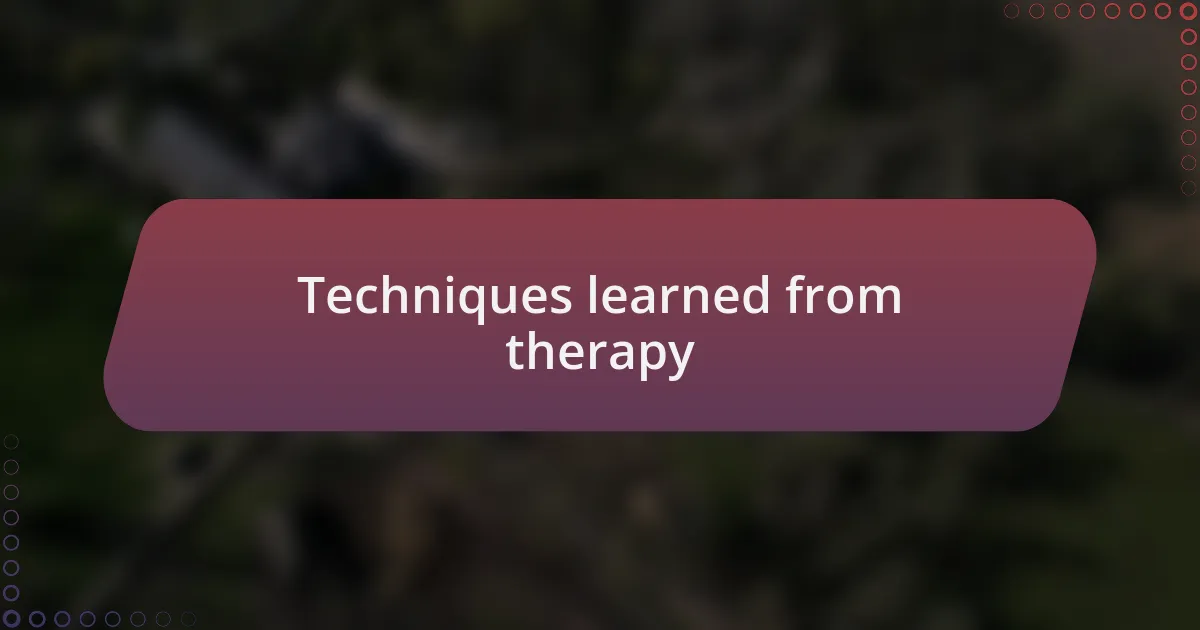
Techniques learned from therapy
Participating in group therapy introduced me to the technique of focusing on vulnerability as a pathway to healing. I vividly remember a session where a member shared their profound anxiety over opening up to others. Their honesty resonated deeply with me, and it sparked a realization: vulnerability can be incredibly liberating. Have you ever experienced that moment when someone else’s courage encourages you to drop your own defenses? I found that when I allowed myself to share my fears, it not only fostered connection but also illuminated the common struggles we all face.
Another critical technique I picked up involves practicing constructive feedback. In one instance, we engaged in a role-playing exercise where we had to provide support to each other. Initially, I was nervous about giving feedback; however, I quickly discovered that framing my comments with empathy and respect helped create a safe space for honest dialogue. This approach not only improved our interactions but also equipped me with tools to communicate in more meaningful ways outside of therapy. Have you ever thought about how the way we express ourselves can either build bridges or create walls?
Additionally, mindfulness emerged as an invaluable technique throughout my therapy journey. There were moments in group sessions where we would take a few minutes to practice breathing exercises. I remember how grounding it felt to center my thoughts in a sea of chaos. Mindfulness isn’t just about quieting the mind; it’s about fostering awareness of the present moment to reduce stress and anxiety. Have you tried incorporating mindfulness into your daily routine? I found that this practice not only enhanced my therapy experience but also seeped into my everyday life, allowing me to approach challenges with greater clarity and calm.
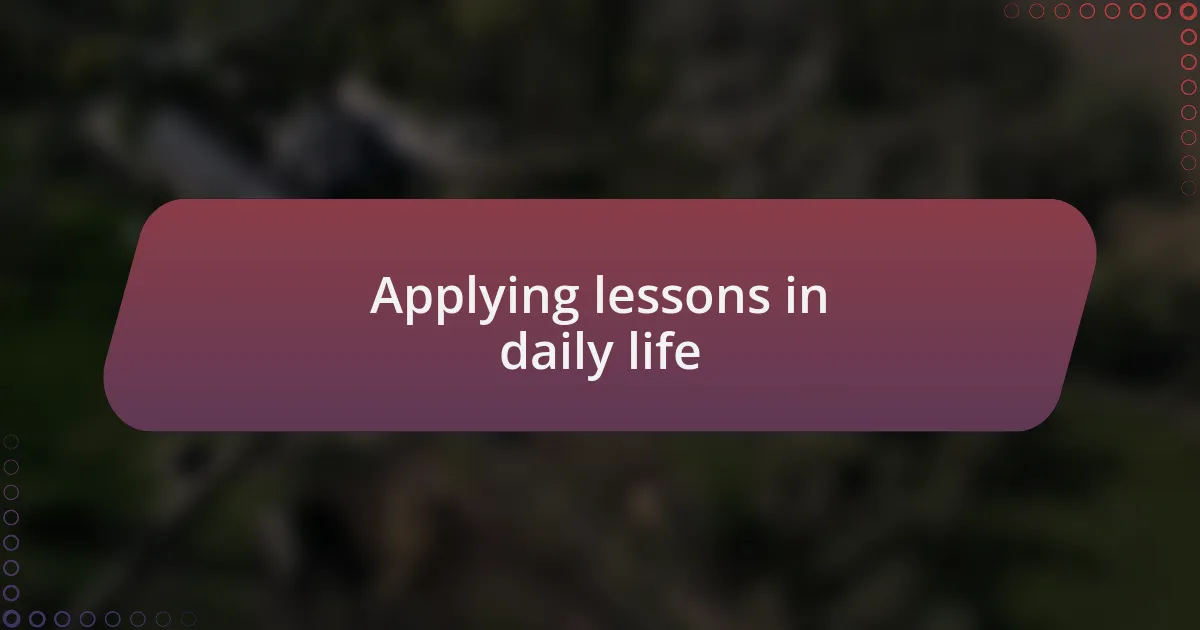
Applying lessons in daily life
It’s fascinating how the lessons from therapy can weave themselves into the fabric of our daily lives. For instance, I started using vulnerability as a strength outside the group setting. There was a day when I felt overwhelmed at work, and instead of hiding my struggle, I shared it with a close colleague. In that moment, I realized that being open led not only to support but also to a deeper professional bond. Have you ever let your guard down with someone and witnessed the positive ripple effects?
Another lesson that has truly transformed my interactions is the art of constructive feedback. I recall a time when a friend approached me for advice on a project. Instead of jumping straight into critiques, I remembered the importance of empathy. I highlighted what they were doing well before offering my suggestions. This shifted our conversation from a potential conflict to a collaborative exchange. It made me wonder: isn’t it amazing how our words can shape someone’s confidence?
Mindfulness has also become a part of my daily practices. Before tackling my to-do list, I take a moment to breathe deeply and reconnect with the present. On particularly hectic days, I find that this simple habit helps me respond rather than react to stressors. Can you think of how much more centered we could all be if we paused to breathe before reacting? Embracing mindfulness in small doses has illuminated my path, reminding me to savor each moment rather than rush through it all.